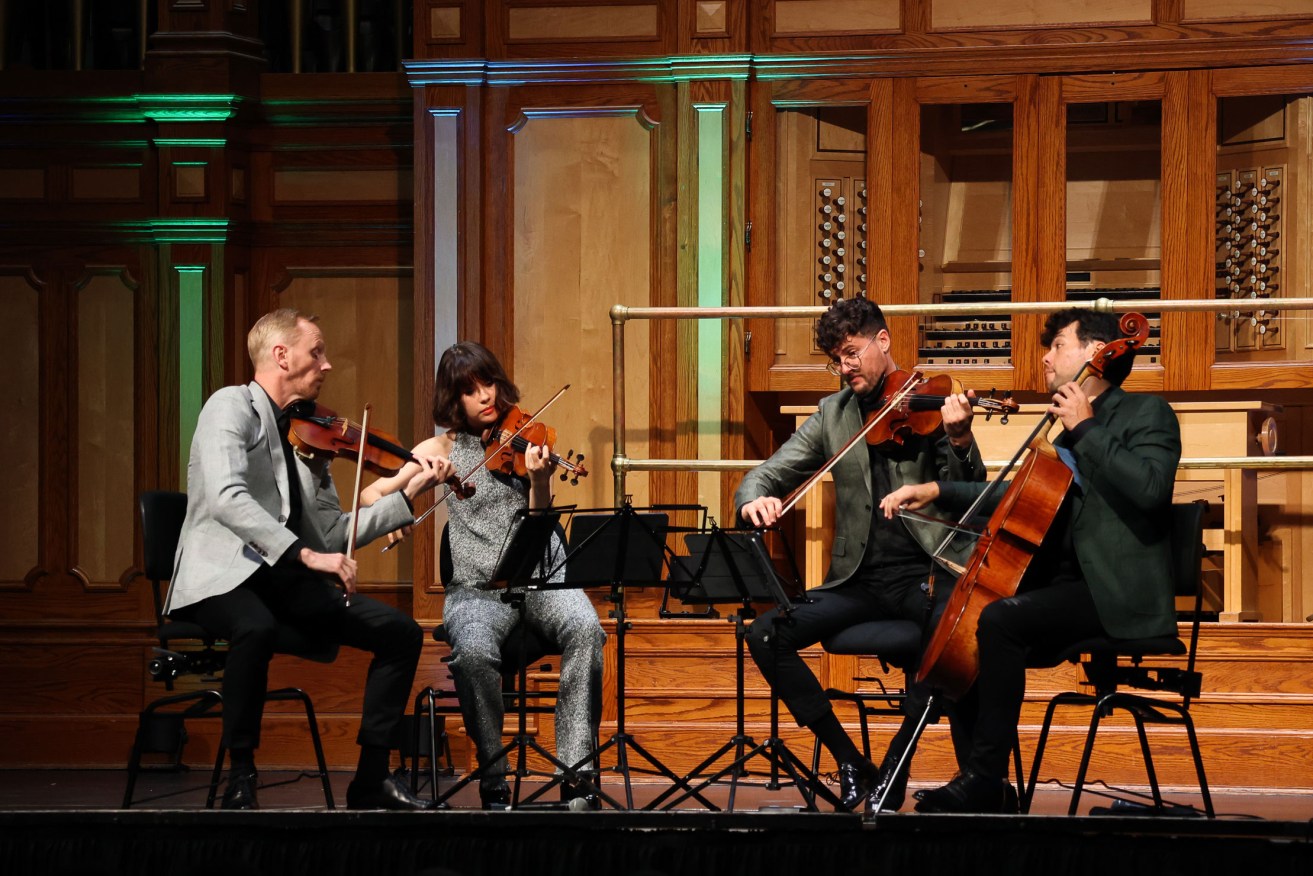Music review: ASQ’s Symonds Beethoven
In what can only be described as one of the most challenging quartet concert programs imaginable, the Australian String Quartet earned a mountain of respect in its performances of a newly commissioned work by Jack Symonds and Beethoven’s towering Op.131.


The Australian String Quartet performs 'Symonds Beethoven' at the Adelaide Town Hall. Photo: Kane Moroney
The placement of these two long and difficult works side by side, with no sweetener in between (other than what you could grab at the drinks bar at interval), was daunting, to say the least. But various things happened in this concert that lifted it far above the ordinary and left one feeling renewed admiration for this group and the music they perform.
In its new configuration with violist Christopher Cartlidge and cellist Michael Dahlenburg, they seem to have found a more intense focus. Cartlidge joined the ASQ in July last year, while Dahlenburg has been with the group since late 2020, and to take nothing away from its previous incarnations, the quartet is extremely evenly matched now, in tone production and musical thinking.
Just hearing them play is a joy, as the blending of instruments is so fine that for the first time the group resembles one single “sound machine”. In virtuosic music – as in Symonds’ String Quartet No.2, and as Beethoven’s Fourteenth String Quartet in C-sharp minor, Op.131, might fairly be described – the result is something at which to marvel. This concert was high precision from the first note to the last, and quite extraordinary to witness.
So that was one thing. But the other was the conjunction of these two works, in which – oddly enough, though clearly intended in the design of this concert – they truly did complement each other. One was mint new and the other is among the most hallowed, canonical creations in chamber music, 196 years older and belonging to an unutterably different world.
Yet in in their searching quality and wrestling with ideas, all within the domain of “pure art”, the Symonds and Beethoven share a similar intent. Never mind their different chronologies: both sounded like freshly “contemporary” works.
Symonds – a Sydney composer whose Blühen chamber song was performed at UKARIA in the 2021 Adelaide Festival – constructs his Second String Quartet in an interesting way. Its two movements contain intentional instabilities that put the piece out of balance, causing it to move in unpredictable directions. The first movement is based around a fast, ascending scale that comes whisper quiet at the beginning as a kind of spectral fluttering in the first violin. Heard against a soulful cello line and gradually shared across the ensemble, this scale disintegrates into a gossamer texture almost like aural spiderwebs.
As the speed gathers, the instruments engage in fabulous cutting and slicing actions, but meanwhile that initial scale keeps reappearing and creating incongruities. The second movement presents six unrelated ideas that are combined in further unexpected ways. This dialectical content propels the work with a distinctive energy, and Symonds’ writing is transparently clear even at its most complex. He understands the string quartet medium so very well.
After this invigorating and brilliant composition, and hearing it receive the highest level of virtuosity, it was back to the familiar – except that Beethoven’s late string quartets are really anything but that. Op.131’s seven movements have no precedent, even within Beethoven’s own oeuvre, and the expressive extremes of its language, veering from the serene to the perverse and the downright comical, can still be baffling today.
Reputedly, Op.131 was Beethoven’s favourite quartet, and Schubert apparently said on hearing it: “After this, what is left for us to write?”
However, the question for now was what the ASQ would choose to do with it interpretationally. The answer came soon enough. Its opening fugue, reminiscent of Bach’s Art of Fugue, possessed a glassy stillness that seemed to be free from the constraints of metrical time, and the group’s precision with tuning gave it unusual cleanliness of texture. There was nothing here remotely like Haydn, Mozart or even middle-period Beethoven: it was shorn of sentiment and thoroughly modern sounding.
Each subsequent movement was philosophically introspective without being weighed down by any imposed profundity. Gliding segues made the whole 40-minute structure feel effortlessly refined and, as it were, one seamless composition.
Particularly wonderful was the unaffected melodic simplicity of the musicians’ playing and the carefully crafted exchanges between pairs of voices in the fourth movement Andante. But most distinctive was the way the ASQ took the scherzo-like fifth movement: lightning quick, it rose and receded in waves rather than being tied down by usual rhythmic strictures. Totally cheeky, it made sense because Beethoven was so obviously having fun by the end of this movement with assorted pizzicato, sul ponticello and other effects.
This cleanly rendered picture of Beethoven is a radical departure from the way this music is traditionally heard. As much as one still may love the way Takács Quartet and other established groups play it, this new window on Op.131 was marvellously refreshing – and technically even more accomplished.
As the group members alluded to more than once in their spoken introductions while on stage, they put months of assiduous work into both pieces. The results certainly showed: this was artistry of the very highest calibre.
The Australian String Quartet performed Symonds Beethoven at the Adelaide Town Hall on Tuesday night and will take it on tour to Victoria, New South Wales and the ACT. The quartet is also performing a concert featuring works by Adès and Beethoven at UKARIA Cultural Centre this Friday morning (October 21).




